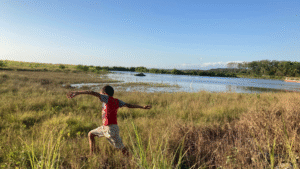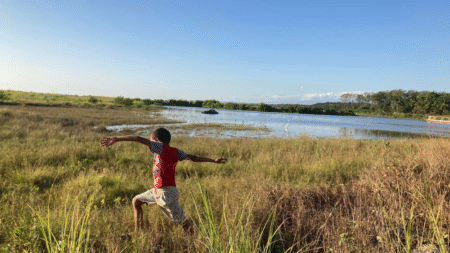Hideo Kojima is excited we are sitting across from each other. I am too, of course, but I was perfectly satisfied just getting the chance to even interview the video game industry legend over Zoom back in September 2024, the last time we spoke.
It’s early June and annual video game expo Summer Game Fest is raging on in Downtown Los Angeles while I meet Kojima and his team in a quiet conference room at a hotel off-site. Kojima is in town to promote the June 26 release of his highly anticipated “Death Strand 2: On the Beach,” the sequel to the Norman Reedus-led 2019 game, and the AAA title’s collaboration with fashion brand GU, which is out Thursday.
I’ve come saddled with bags of items I’ve already gathered while working the event, including one featuring the “Magic: The Gathering” and “Final Fantasy” collaboration, and it’s the first thing Kojima notices when I go to shake his hand. It’s also a great entry point into our conversation about both the “Death Stranding” sequel game and why Kojima wanted to do another branded fashion collaboration with GU.
2025’s “Death Stranding 2: On the Beach“
“I’ve teamed up with GU before, and it’s always very well received. People who don’t know my games might buy these products because they know GU and happen to like our designs,” Kojima said. “And when they’re wearing it, someone might say, ‘Hey, that’s ‘Death Stranding’.” That might lead to them becoming interested in the game. It’s almost like a walking billboard. If you’re wearing a Kojima Productions T-shirt, a fan could come up to you and say, ‘You’re wearing a Kojima Productions T-shirt; I’m a fan!” It allows for the communication to grow between people whom you’ll never know are fans of ‘Death Stranding’ or of Hideo Kojima. The fashion gives you a talking point.”
Kojima added: “It’s like your bag there — ‘Final Fantasy.’ I spotted that right away and said to you, ‘Hey, that’s Final Fantasy!’ That’s exactly what I mean. If you’re wearing a brand, it makes it possible for people to connect with you. So, of course, we want the fans of our game to buy these items but also for non-‘Death Stranding’ fans to wear this and promote it – for lack of a better term.”
It’s doubtful Kojima’s “Death Stranding 2: On the Beach” will need much promotion to be a big hit for Kojima Productions and publisher PlayStation, as the award-winning maker behind “Metal Gear Solid,” has a passionate and wide fanbase — and a “Death Stranding” movie in the works at A24 to fuel even more hype — but the chance to promote it in person is a luxury Kojima hasn’t had in years.
Here, Kojima breaks down the making of “Death Stranding 2: On the Beach,” how the importance and complexities of an in-person conversation connect to the new game’s themes, and how production is moving along on A24’s “Death Stranding” movie.
How did the GU collaboration came about?
I grew up watching movies, and I learned about different cultures through these movies. For example, I learned about tipping in the U.S. I also discovered music and fashion – like Mike Oldfield from “The Exorcist.” I didn’t know progressive rock until I watched that movie.
Movies are entertainment – as are games – but games are very isolated. You don’t get as much out of games as you do other entertainment. There’s game music, but it only reaches gamers. When people play my games, I want them to learn something new, whether that’s music or fashion or so on. That’s why I put a lot of focus on music in “Death Stranding,” featuring many bands. I also collaborate with fashion brands, like Acronym for example. It’s a high-end brand and can be a bit out of reach for a lot of younger gamers. But I wanted to keep the concept and collaborate with someone more accessible. That’s why I thought GU was perfect for that. Their quality is great, and they take into consideration our feedback, which is really nice.
I’ve teamed up with GU before, and it’s always very well received. People who don’t know my games might buy these products because they know GU and happen to like our designs. And when they’re wearing it, someone might say, “Hey, that’s ‘Death Stranding’.” That might lead to them becoming interested in the game. It’s almost like a walking billboard. If you’re wearing a Kojima Productions T-shirt, a fan could come up to you and say, “You’re wearing a Kojima Productions T-shirt; I’m a fan!” It allows for the communication to grow between people whom you’ll never know are fans of “Death Stranding” or of Hideo Kojima. The fashion gives you a talking point.
It’s like your bag there — “Final Fantasy.” I spotted that right away and said to you, “Hey, that’s Final Fantasy!” That’s exactly what I mean. If you’re wearing a brand, it makes it possible for people to connect with you. So, of course, we want the fans of our game to buy these items but also for non-‘Death Stranding’ fans to wear this and promote it – for lack of a better term.

How would you define your own esthetic and sense of style?
I like the European style. I like darker tones and tighter fitting clothes – not oversized and baggy. It’s quite difficult to work in a suit, so I wear very casual clothes at the studio. It’s also quite hot in the office because of all the computers, so I see most of my staff in short-sleeved T-shirts.
Even in the winter, I just wear a warm coat over a T-shirt, and I’m typically in a T-shirt at the office. That’s my style of fashion.
When it comes to making a collaboration and figuring out what you might aspire to wear, what you think other people would aspire to wear, and tying it into the game’s aesthetic, what are you looking for?
I don’t really give specific instructions. I’ve collaborated with companies for watches and eyeglasses, but more than anything, it’s about the mutual trust that we have with each other. I want to be able to talk with the people in charge and designers and so on. I only collaborate with people who’ll let me work with them directly – like this Hamilton collaboration watch. I didn’t care so much about making it “Death Stranding”-like but more that I wanted to highlight the appeal of the brand and make sure they’re represented well.
Speaking of the thematic and aesthetic differences between “DS1” and “DS2,” what inspired the transition?
I planned “Death Stranding 2” before the pandemic and was already testing some things out, but after the pandemic hit, I fell quite ill. For the first time in my life, I thought I could never make another game, and I felt very isolated. I didn’t know what to do. I couldn’t even visit the hospital. I was in a crisis unlike anything I’ve ever experienced before in my life. But as the pandemic raged on, I knew I had to keep working on the game – for the sake of the company.
Fortunately, we had the internet during the pandemic. It was a totally different situation a hundred years ago during the Spanish flu. So, although the pandemic was worldwide, we were still connected and could order things on Amazon, have virtual calls with doctors, hold interviews via Zoom, and companies started remote work. You didn’t have to go to the office. No one at Kojima Productions came to the office either; I was the only one there. Yoji came maybe twice a week or so. I was all alone and had no one to talk to about my ideas. The only form of communication was through email, and those were used to just send reports. Creating something in an environment like that was extremely difficult.
When it came time to do the performance capture, it was all shot in LA, but we couldn’t go there due to the pandemic travel restrictions. I directed remotely from Tokyo, but it was nearly impossible. Even drinking parties and music concerts were held virtually.
Around this time, the term “Metaverse” started to become widely used. Many people moved out of the city and relocated to the suburbs. But remote work was very inefficient. Progress on game development was very slow. It was different from shooting a movie where everyone gathered on set and filmed together, after passing inspections for COVID.
We also hired new staff through virtual interviews during the pandemic. They would come in on the first day, only to never see them again after that. You don’t get to learn who they are or understand them. Even on Zoom calls, some people blur their background, so you can’t tell where they are or what they’re doing.
The message behind the first “Death Stranding” was, “Humanity will go extinct if we remain isolated and divided.” Then, I really wanted to rewrite “Death Stranding 2” after experiencing the pandemic. I don’t want to say too much and give away spoilers. Even this interview – we could have done it over Zoom like we did last time. But, this time you are here, and we are talking face to face. And you probably experienced a lot of unexpected things on your way here. I’m not denying technology – I think remote work has its advantages – but that’s not all that we need. We need to see one another in person.
By the end of 2022, we were allowed to travel to LA to do performance capture for the first time in about 2 years. That night, we went out to dinner with the actors, and I thought, “This is what we need.” We need to be together, shoot together, and celebrate together.

2019’s “Death Stranding”/Kojima Productions
Courtesy of Sony Interactive Entertainment
Between “Death Stranding” and “Death Stranding 2: On the Beach,” are there specific ways the second game was created that differed from the original? Were there new visual effects that you enjoyed making, or things that you could do with this game that you couldn’t do with “Death Stranding 1”?
Technology doesn’t just appear out of nowhere; it’s always been cutting edge, even back in the days of “DS1.” Some people might say, “Oh, it looks nicer now,” but behind the scenes, there’s been a continuous technological evolution that’s never stopped. For example, when we scanned Léa Seydoux for “DS1” and “DS2,” we used the same scanning process. We created her model and did performance capture. We put her in a suit and wrote dots on her face, and she did all the movements and acting.
It’s the same with “Avatar 1” or “Avatar 2.” But you compare the two and you see that “Avatar 2” is much better. The technology wasn’t necessarily new; it was the same between 1 and 2. In “Death Stranding,” you can see the difference between Léa’s face and how it’s much better in “DS2.” What we did, however, did not change. All the expressions and rigs we created for her face – it looks much more photorealistic. I’m not yet satisfied, but it’s better.
Something revolutionary doesn’t just pop up. Things advance slowly, day by day, as an extension of the already existing technology. But there are breakthroughs sometimes, maybe every five or ten years, and those can be game changers. Right now, the performance capture technology involves going to a studio filled with cameras, wearing a suit with markers and balls on it, and having a camera in your face that’s attached to a helmet. That may change in the next five years, and maybe that’s when technology will step up drastically. But typically, it’s a gradual change, like from “DS1” to “DS2.” Everything has become better, in a way, but the way you do it hasn’t changed yet.
You may have seen the scene of Norman Reedus and Léa kissing in the teaser trailer. We shot this during their performance capture. They can’t really kiss with the cameras in front of their faces, so we asked them to pretend like they were kissing and holding each other while being careful not to bump their cameras. We shot that from all angles – 360 degrees. Then, we had them take off their helmet cameras and asked them to kiss for real. We shot that from 360 degrees also, and we blended both of those data. However, in the future, you may not need a camera in your face – that will be the revolutionary breakthrough years from now. You could be shooting a live action film, but maybe there are lasers or something and instead of just 2D data, you can capture 3D data at the same time, meaning you could change the camera settings afterwards or make it into a game without having to reshoot anything. That’s what’s probably going to happen in the next five to ten years.
So, to reiterate, we didn’t really have a breakthrough in technology between “DS1” and “DS2” but rather a slow progression. When I first started in the games industry, we didn’t have CD-ROMs and putting dialogue in required too much data. Later, when CD-ROMs were introduced, you could add music and dialogue. Further down the line, compression technology enabled us to have cutscenes in games. With the arrival of the PlayStation, games could now appear in 3D. These were breakthroughs in technology, but we didn’t have anything like that during “DS1” and “DS2.” I’m sure we’ll see it in the near future, though.
You said that you were close to being satisfied, but not. Do you think that you will reach a point where you are?
I don’t think there’ll ever come a time when I’m satisfied. There may be things I can’t do today but that I’ll be able to do tomorrow because of advancements. There are new things coming, and technology advances every day, which is what makes it so fun to be in the games industry. In the past, I never thought I would be working with Hollywood actors for a game, because I used to just work with pixelated characters. But nowadays, you can work with all kinds of professionals – like architects in order to make a building or psychologists to create a character profile. Everything is expanding and moving forward. If it were moving backwards, if technology was worsening, then it would be hard for creators to be imaginative. Fortunately, that’s not the case. Even fashion too, for example: Hanae Mori designed clothes for “Space Battleship Yamato.” That was unbelievable. I thought we could never do things like that in the games industry, but that’s recently changed. We can team up with the fashion world now because we can incorporate more details; that was not possible in the past.
How involved do you think you’ll be able to be in the “Death Stranding” film, while you still have so many plans on the gaming side?
I think I will help produce it – I need to kind of guide the project – but I can’t direct it myself, schedule-wise. I made “Death Stranding” as a game, so in order to turn it into a movie, it’ll be something totally different. But it’s my baby, so I would like to overlook the project. I’m teaming up with A24 and Michael Sarnoski, so he will be writing and directing. I’ll let them work on it without too much of my input, because that might get in their way. I don’t want to go in and ask them to make a bunch of changes; that’s not cool. I have to trust these people, and I trust A24 and Michael.
This interview was conducted via in-person translator and has been edited, condensed and reviewed for accuracy.
See more from the newly released “Death Stranding 2: On the Beach” collaboration between Kojima and GU in the images below.









Read the full article here








